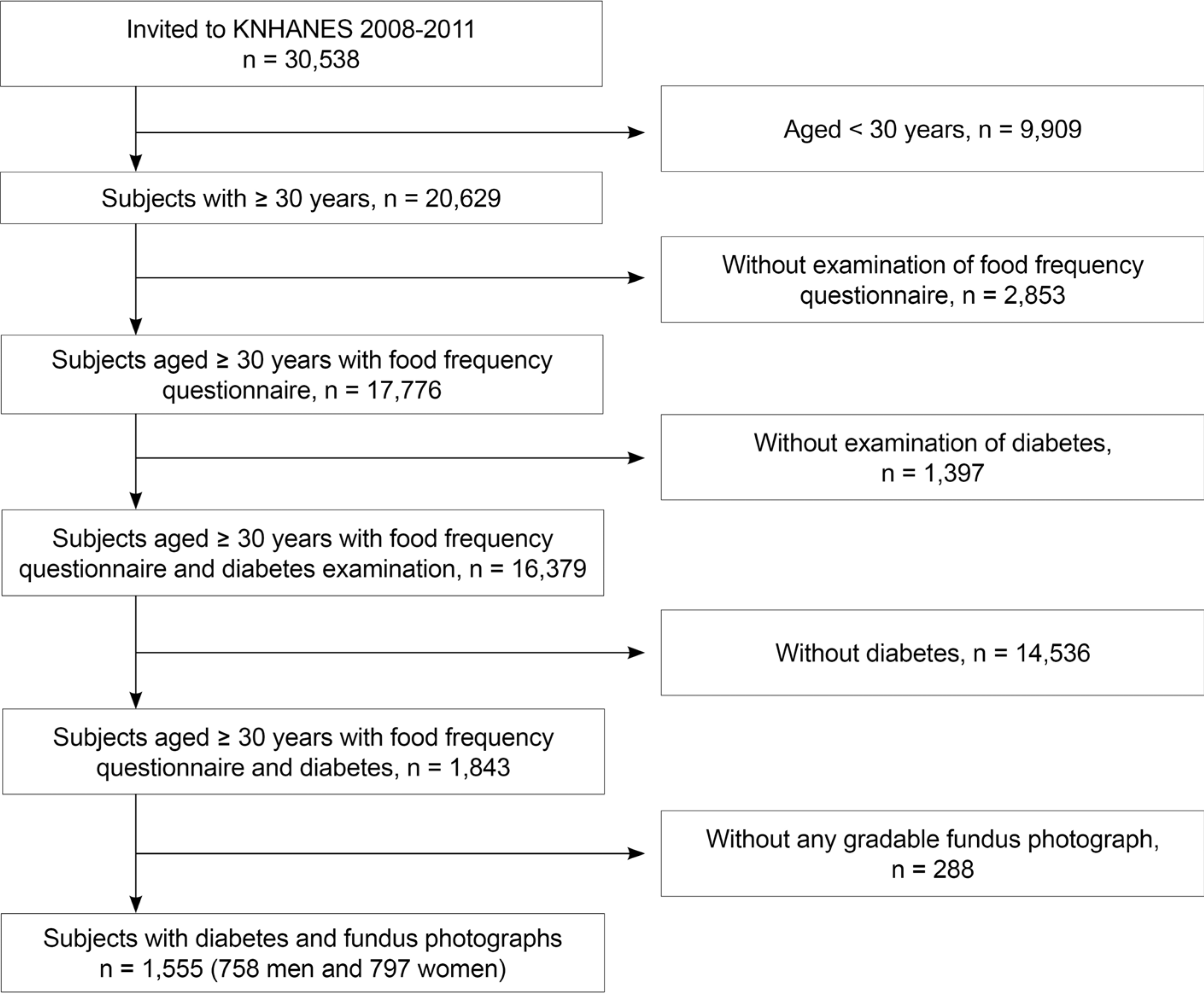1). Klein BE. Overview of epidemiologic studies of diabetic retinopathy. Ophthalmic epidemiol. 2007; 14:179–83.
2). Aiello LP, Gardner TW, King GL, et al. Diabetic retinopathy. Diabetes Care. 1998; 21:143–56.

3). Brown MM, Brown GC, Sharma S, Shah G. Utility values and diabetic retinopathy. Am J Ophthalmol. 1999; 128:324–30.

4). Wong TY, Klein R, Islam FM, et al. Diabetic retinopathy in a multi-ethnic cohort in the United States. Am J Ophthalmol. 2006; 141:446–55.

5). Williams R, Airey M, Baxter H, et al. Epidemiology of diabetic retinopathy and macular oedema: a systematic review. Eye (Lond). 2004; 18:963–83.

6). Kempen JH, O'Colmain B, Leske MC, et al. The prevalence of diabetic retinopathy among adults in the United States. Arch Ophthalmol. 2004; 122:552–63.

7). Yau JW, Rogers SL, Kawasaki R, et al. Global prevalence and major risk factors of diabetic retinopathy. Diabetes Care. 2012; 35:556–64.

8). Jee D, Lee WK, Kang S. Prevalence and risk factors for diabetic retinopathy: the Korea National Health and Nutrition Examination Survey 2008-2011. Invest Ophthalmol Vis Sci. 2013; 54:6827–33.

9). Jee D, Kim EC. Inverse association between high blood 25-hydroxyvitamin D levels and diabetic retinopathy in a representative Korean population. PLoS One. 2014; 9:e115199.

10). Ghadiri Soufi F, Arbabi-Aval E, Rezaei Kanavi M, Ahmadieh H. Anti-inflammatory properties of resveratrol in the retinas of type 2 diabetic rats. Clin Exp Pharmacol Physiol. 2015; 42:63–8.

11). Losso JN, Truax RE, Richard G. Trans-resveratrol inhibits hyperglycemia-induced inflammation and connexin downregulation in retinal pigment epithelial cells. J Agric Food Chem. 2010; 58:8246–52.

12). Kim YH, Kim YS, Roh GS, et al. Resveratrol blocks diabetes-induced early vascular lesions and vascular endothelial growth factor induction in mouse retinas. Acta Ophthalmol. 2012; 90:e31–7.

13). Yar AS, Menevse S, Dogan I, et al. Investigation of ocular neo-vascularization-related genes and oxidative stress in diabetic rat eye tissues after resveratrol treatment. J Med Food. 2012; 15:391–8.

14). Soufi FG, Mohammad-Nejad D, Ahmadieh H. Resveratrol improves diabetic retinopathy possibly through oxidative stress - nuclear factor kB - apoptosis pathway. Pharmacol Rep. 2012; 64:1505–14.
15). Rokicki D, Zdanowski R, Lewicki S, et al. Inhibition of proliferation, migration and invasiveness of endothelial murine cells culture induced by resveratrol. Cent Eur J Immunol. 2014; 39:449–54.
16). Liu XQ, Wu BJ, Pan WH, et al. Resveratrol mitigates rat retinal ischemic injury: the roles of matrix metalloproteinase-9, inducible nitric oxide, and heme oxygenase-1. J Ocul Pharmacol Ther. 2013; 29:33–40.

17). Bola C, Bartlett H, Eperjesi F. Resveratrol and the eye: activity and molecular mechanisms. Graefes Arch Clin Exp Ophthalmol. 2014; 252:699–713.

18). Semba RD, Ferrucci L, Bartali B, et al. Resveratrol levels and all-cause mortality in older community-dwelling adults. JAMA Intern Med. 2014; 174:1077–84.

19). Park HA. The Korea national health and nutrition examination survey as a primary data source. Korean J Fam Med. 2013; 34:79.

20). Kim Y, Park S, Kim NS, Lee BK. Inappropriate survey design analysis of the Korean National Health and Nutrition Examination Survey may produce biased results. J Prev Med Public Health. 2013; 46:96–104.

21). Rim HT, Park SY, Yoon JS. Hormone replacement therapy and eye diseases: KNHANES IV. J Korean Ophthalmol Soc. 2012; 53:1445–50.

22). Lim HT, Choi KS. Factors associated with screening for diabetic retinopathy in diabetic patients aged > or = 40 years using the KNHANES IV. J Korean Ophthalmol Soc. 2012; 53:516–21.
23). Diabetic retinopathy study. Report Number 6. Design, methods, and baseline results. Report Number 7. A modification of the Airlie House classification of diabetic retinopathy. Prepared by the Diabetic Retinopathy. Invest Ophthalmol Vis Sci. 1981; 21((1 Pt 2)):1–226.
24). Willett WC, Sampson L, Stampfer MJ, et al. Reproducibility and validity of a semiquantitative food frequency questionnaire. Am J Epidemiol. 1985; 122:51–65.

25). Kim SJ, Choi MK. Factors Associated with Fruit and Vegetable Consumption of Subjects Having a History of Stroke: Using 5th Korea National Health and Nutrition Examination Survey (2010, 2011). J Comm Nutr. 2014; 19:468–78.

26). Scanlon PH, Aldington SJ, Stratton IM. Epidemiological issues in diabetic retinopathy. Middle East Afr J Ophthalmol. 2013; 20:293–300.

27). Marmot MG, Rose G, Shipley MJ, Thomas BJ. Alcohol and mortality: a U-shaped curve. Lancet. 1981; 1((8220 Pt 1)):580–3.

28). Shaper AG, Wannamethee G, Walker M. Alcohol and mortality in British men: explaining the U-shaped curve. Lancet. 1988; 2:1267–73.

29). Biagi M, Bertelli AA. Wine, alcohol and pills: What future for the French paradox? Life Sci. 2015; 131:19–22.

30). Wollin SD, Jones PJ. Alcohol, red wine and cardiovascular disease. J Nutr. 2001; 131:1401–4.

31). Guerrero RF, Garcia-Parrilla MC, Puertas B, Cantos-Villar E. Wine, resveratrol and health: a review. Nat Prod Commun. 2009; 4:635–58.

32). Pendurthi UR, Williams JT, Rao LV. Resveratrol, a polyphenolic compound found in wine, inhibits tissue factor expression in vascular cells: a possible mechanism for the cardiovascular benefits associated with moderate consumption of wine. Arterioscler Thromb Vasc Biol. 1999; 19:419–26.
33). Stervbo U, Vang O, Bonnesen C. A review of the content of the putative chemopreventive phytoalexin resveratrol in red wine. Food Chemistry. 2007; 101:449–57.

34). Romero-Pérez AI, Lamuela-Raventós RM, Andrés-Lacueva C, de la Torre-Boronat MC. Method for the quantitative extraction of resveratrol and piceid isomers in grape berry skins. Effect of powdery mildew on the stilbene content. J Agric Food Chem. 2001; 49:210–5.

35). Press SJ, Wilson S. Choosing between logistic regression and discriminant analysis. J Amer Statist Assoc. 1978; 73:699–705.






 PDF
PDF ePub
ePub Citation
Citation Print
Print


 XML Download
XML Download